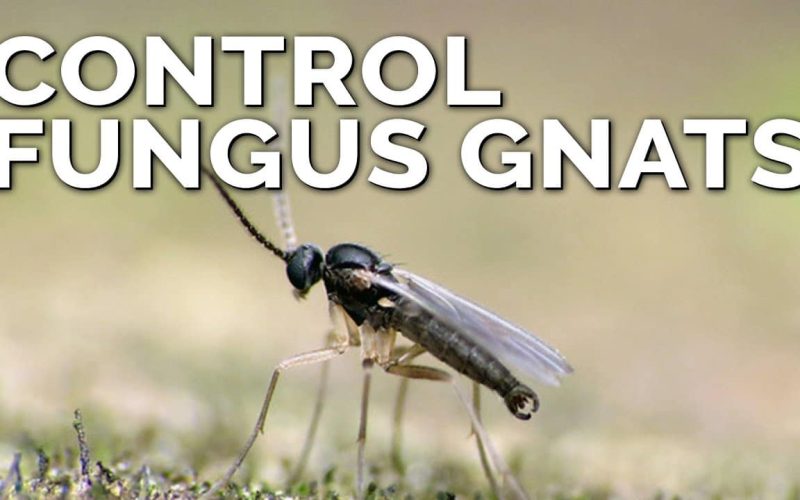Fungus gnats are tiny, dark flying insects that grow to half an inch, between 1/8 and 1/16 of an inch.
They also have a very short lifespan, where the adults only live for about one to two weeks.
This article aims to examine ways how to get rid of fungus gnats.
These tiny creatures belong to Sciaridae, Diadocidiidae, Ditomyiidae, Keroplatidae, Bolitophilidae, and Mycetophilidae (order Diptera).
They inhabit warm, moist houseplant soil and outdoor compost. Fungus gnats primarily affect indoor houseplants because moisture attracts them.
The adults can reproduce at an astonishing rate of about 200 eggs a day near the soil surface.
These gnats develop through four stages: egg, larva, pupa, and adult. As stated earlier, they have a brief lifespan.
The adults are harmless; they don’t bite or spread disease but can be a nuisance as they fly around the home.
They can be annoying as they fly into your faces, eyes, and noses indoors and outdoors.
Apart from their obvious nuisance, the fungus gnat larvae are the perfect example of “small but mighty.” They can damage plants, especially young plants.
Talk about the young attacking the young. The fungus gnats’ larvae feed on the organic matter in the soil and the plants’ thin roots.
More so, fungus gnats may also spread Pythium. Pythium is a group of plant pathogens capable of causing “damping off” in seedlings.
It behooves us to figure out ways to deal with these insects and restore our homes and plants to their former glory.
How to Get Rid of Fungus Gnats?
Fungus gnats thrive on excess water and moisture near plant roots. So, controlling the moisture of your plants is one surefire way to deal with them.
Refrain from overwatering your growing media. Waterlogged growing medium in houseplants is the primary breeding ground for these insects.
When you do overwater, ensure that standing water does not remain in saucers below houseplants. Keep reading as we look at how to get rid of fungus gnats.
1. Use Sticky Traps
One of the ways to get rid of fungus gnats is the use of sticky traps. They work well in capturing the adult fungus gnats as they fly around the house.
If the fungus gnats’ menace is discovered early on, good use of sticky traps can go a long way in dealing with them.
Some options are Flypaper, yellow sticky cards, or modern decorative sticky traps.
To use this, place the sticky traps horizontally at the soil surface to capture large numbers of egg-laying adults.
You can place these traps around the infested houseplants, directly on the soil, or around the windows. The modern-day version of these sticky traps comes in various shapes and sizes.
Some come as stakes, like miniature trees with goopy and loopy leaves.
To do your stakes, cut the sticky notes into small squares, attach them to skewers, and insert them into pots just above the soil where adults tend to crawl and fly.
These adult gnats and the freshly pupated ones emerging from the soil will fly or crawl onto the card and become trapped in the glue.
The sticky card works well, but the downside is that it can’t deal with the fungus gnat larvae. Keep reading as we examine more options.
2. Insect Spray
Another method to get rid of fungus gnats is insect spray. Sticky traps will help eliminate the flying gnats, but they can’t deal with larvae still in the soil.
Considering that these larvae affect the plant’s roots and that every adult gnat was once a larva, it is expedient to deal with the larvae.
The insect spray does that well enough. It deals with both larvae and flying adults.
Your choice of insect spray should be carefully considered. Use the ones that are organically safe and target the gnats.
Neem oil can also be used as insect spray here. It is safe for use in greenhouses, gardens, and indoors.
To deal with the adults, spray the upper portion of the plant to keep them at bay.
To deal with the larvae, mix the oil with water according to the manufacturer’s instructions and directly drench the soil at the plant’s roots.
The insecticide azadirachtin, which is derived from neem oil and lacks the greasiness of that oil, works great here, too.
Pyrethrin spray is also an effective fungus gnat killer. It should be misted all over the plant’s surfaces and the top of the soil.
When using it on the soil, ensure that the soil isn’t water-soaked. It should be at least 2″ depth dry.
Using this consistently for a period of three to four weeks goes a long way.
Other sprays are formulated with essential oils like peppermint, cinnamon, and sesame oils, which are non-toxic, safe to use around kids, and will get rid of gnats.
3. Apple Cider Vinegar Trap
Using an apple cider vinegar trap to avoid using an insecticide is also a great way to get rid of fungus gnats.
It is effective because fungus gnats are attracted to the smell of vinegar. So, how do you go about setting this trap? To do this, you would need the following:
- A shallow container (about the size of a tuna can)
- 1/4 inch of equal part water and apple cider vinegar
- A few drops of liquid dish soap (soap breaks the surface tension of the liquid and prevents the gnats from landing safely on the surface, causing them to be pulled in and drown).
You can make yourself a good fungus gnat trap with the four items above. To fix this trap,
- Fill the container with the amount of cider vinegar and water stated above
- Add a few drops of liquid dish soap and gently stir the mixture.
- Place the trap near the base of the affected plant or inside the pot on top of the soil. The vinegar will lure the gnats in, and the soap will cause them to drown.
Check the trap daily to refresh it with new vinegar and water as they attract and kill these adult fungus gnats.
4. Biological Removal
Another excellent tactic for getting rid of fungus gnats is biological means. This involves introducing some species to deal with these gnats.
To do this, we will have to go the safe route. If you are not careful in introducing biological weapons, you may have a bigger problem while dealing with a minor issue.
The first weapon to be utilized here is beneficial nematodes. They are safe for use around pets, plants, and your family.
These nematodes are microscopic roundworms that can penetrate the fungus gnat larvae, fleas, and other soil-borne pests (they do not harm earthworms).
These nematodes will seek and destroy the fungus larvae ( remember that these larvae are the ones sucking the life out of your precious plants by nibbling on the roots) by releasing a bacterium that consumes the pest from the inside out, which prevents the next generation of adults from forming.
Of course, you can’t see them, considering they are microscopic, but they work fine.
You can incorporate these nematodes into the infested soil with a pot popper. If your aim is on a larger scale, you can use commercial designs, which disperse the nematodes evenly with water.
The second biological weapon to eliminate the fungus gnat is the bacteria Bacillus thuringiensis var. israelensis.
These bacteria kill damaging larvae, yet they are safe for fish, wildlife, humans, and non-target species and contain no harmful residues.
One way to introduce these bacteria is through Mosquito Dunks. Well, mosquito dunks don’t only kill mosquitoes or control mosquito larvae from populating fountains, animal troughs, and other small bodies of water.
As these mosquito dunks break down, they release Bacillus thuringiensis var. israelensis into your soil. Here, these bacteria get to work killing fungus gnats’ larvae too.
To achieve this, soak mosquito dunks in a gallon of water overnight. The following day, use that water to continue dredging the surface of your potting soil.
The bacteria will have penetrated the water and will now infect and kill the fungus gnat larvae that come into contact with it in the soil.
It can be used both indoors and outdoors. This process can be repeated each time you water your plants for at least a few months, and you will see a visible result.
5. Hydrogen Peroxide Solution
The use of hydrogen peroxide solution is also an answer to getting rid of fungus gnats. To do this, use the standard 3% topical variety.
One part peroxide is mixed with seven parts water to make this solution.
Pour this mixture through the soil at the root region (avoid getting the leaves wet) until the hydrogen peroxide solution comes out of the pot’s base.
The hydrogen peroxide is effective against fungus gnat larvae on contact.
Note that when using hydrogen peroxide solution, avoid the use of beneficial nematodes at the same time.
If you do this, the hydrogen peroxide solution will kill the nematodes. If you use the solution, wait weeks before introducing nematodes back into the soil.
6. Dispose of the Top Layer of Soil Outdoors and Replace It with Sterilized Potting Soil
Another method for getting rid of fungus gnats palaver is to remove the top 2 inches of the infested soil outdoors and replace it with sterilized potting soil.
You can also sprinkle sand over the surface, as fungus gnats aren’t fans of sand since it dries out quickly and contains none of that rotting organic debris they love. More so, only mix compost into your potting soil if it has been sterilized.
7. Call a Professional
Getting rid of these tiny creatures can sometimes be daunting. You may not be able to endure the hassle of the above, or perhaps you’ve tried some methods that don’t seem to go away.
Whatever the case, it’s time to call a professional to deal with them. This is also a great choice for getting rid of fungus gnats.
You can contact a pest control company professional. The exterminators can identify the affected areas, treat them, and offer solutions to prevent future infestations.
You can also schedule with the professionals within a timeframe for when they will deal with preventive tactics and future occurrences.








